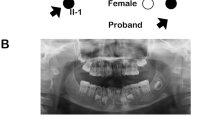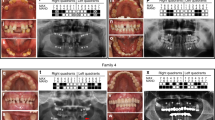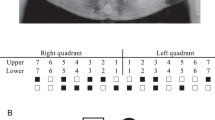Abstract
Tooth agenesis constitutes the most common anomaly of dental development in humans. In the majority of familial cases of hypodontia alone or in association with other anomalies, the mode of inheritance is autosomal dominant. In the present study, we have identified two distantly related consanguineous Pakistani kindreds with an autosomal recessive form of oligodontia with associated dental anomalies. Locus in this case has been mapped on chromosome 4p16.1–p16.3. The maximum two-point LOD score of 2.85 (θ=0.0) was obtained at markers D4S2925 and D4S2285. A maximum multipoint LOD score exceeding 4 was obtained at the same markers. Recombination events observed in affected individuals localized the disease locus between markers D4S412 and D4S2935, spanning a 9.24-cM region on chromosome 4p16.1–p16.3. Sequence analysis of candidate gene MSX1 revealed a novel recessive missense mutation resulting in substitution of alanine to threonine amino acid (p. A219T), located in the MSX1 homeodomain, which is important for DNA binding and protein–protein interaction. The mutation, p. A219T, is the first recessive mutation identified in MSX1.
Similar content being viewed by others
Log in or create a free account to read this content
Gain free access to this article, as well as selected content from this journal and more on nature.com
or
References
Aasheim B, Ogaard B (1993) Hypodontia in 9-year-old Norwegians related to need of orthodontic treatment. Scand J Dent Res 101:257–260
Ahmad W, Brancolini V, ul Faiyaz MF, Lam H, ul Haque S, Haider M, Maimon A, Aita VM, Owen J, Brown D, Zegarelli DJ, Ahmad M, Ott J, Christiano AM (1998) A locus for autosomal recessive hypodontia with associated dental anomalies maps to chromosome 16q12.1. Am J Hum Genet 62:987–991
Apajalahti S, Arte S, Pirinen S (1999) Short root anomaly in families and its association with other dental anomalies. Eur J Oral Sci 107:97–101
Arte S Pirinen S (2004) Hypodontia. Orphanet encyclopedia (http://www.orpha.net/data/patho/GB/uk-hypodontia.pdf)
Arte S, Nieminen P, Pirinen S, Thesleff I, Peltonen L (1996) Gene defect in hypodontia: exclusion of EGF, EGFR, and FGF-3 as candidate genes. J Dent Res 75:1346–1352
Arte S, Nieminen P, Apajalahti S, Haavikko K, Thesleff I, Pirinen S (2001) Characteristics of incisor-premolar hypodontia in families. J Dent Res 80:1445–5140
Axrup K, D Avignon M, Hellgren K, Herikson CO, Juhlin IM, Larsson KS (1966) Children with thalidomide embryopathy: odontological observations and aspects. Acta Odontol Scand 24:3–21
Baccetti T (1998) A clinical and statistical study of etiologic aspects related to associated tooth anomalies in number, size, and position. Minerva Stomatol 47:655–663
Billeter M, Qian YQ, Otting G, Muller M, Gehring W, Wuthrich K (1993) Determination of the nuclear magnetic resonance solution structure of an antennapedia homeodomain–DNA complex. J Mol Biol 234:1084–1093
Bjerklin K, Kurol J, Valentin J (1992) Ectopic eruption of maxillary first permanent molars and association with other tooth and developmental disturbances. Eur J Orthod 14:369–375
Broman KW, Murray JC, Sheffield VC, White RL, Weber JL (1998) Comprehensive human genetic maps: individual and sex-specific variation in recombination. Am J Hum Genet 63:861–869
Catron KM, Zhang H, Marshall SC, Inostroza JA, Wilson JM, Abate C (1995) Transcriptional repression by MSX-1 does not require homeodomain DNA-binding sites. Mol Cell Biol 15:861–871
Chen Y, Bei M, Woo I, Satokata I, Maas R (1996) MSX1 controls inductive signaling in mammalian tooth morphogenesis. Development 122:3035–3044
Cottingham R, Indury RM, Schaffer AA (1993) Faster sequential genetic linkage computations. Am J Hum Genet 53:252–263
Davidson D (1995) The function and evolution of MSX genes: pointers and paradoxes. Trends Genet 11:405–411
De Muynck S, Schollen E, Matthijs G, Verdonck A, Devriendt K, Carels C (2004) A novel MSX1 mutation in hypodontia. Am J Med Genet A 128:401–403
Grimberg J, Nawoschik S, Bellusico L, McKee R, Turck A, Eisenberg A (1989) A simple and efficient non-organic procedure for the isolation of genomic DNA from blood. Nucleic Acid Res 17:61–68
Gudbjartsson DF, Jonasson K, Frigge ML, Kong A (2002) Allegro, a new computer program for multipoint linkage analysis. Nat Genet 25:12–13
Haley J, Whittle N, Bennett P, Kinchington D, Ullrich A, Waterfield M (1987) The human EGF receptor gene: structure of the 110 kb locus and identification of sequences regulating its transcription. Oncogene Res 1:375–396
Houzelstein D, Cohen A, Buckingham ME, Robert B (1997) Insertional mutation of the mouse MSX1 homeobox gene by an nlacZ reporter gene. Mech Dev 65:123–133
Hu G, Vastardis H, Bendall AJ, Wang Z, Logan M, Zhang H, Nelson C, Stein S, Greenfield N, Seidman CE, Seidman JG, Abate-Shen C (1998) Haploinsufficiency of MSX1: a mechanism for selective tooth agenesis. Mol Cell Biol 18:6044–6051
Isaac VE, Sciavolino P, Abate C (1995) Multiple amino acids determine the DNA binding specificity of the MSX-1 homeodomain. Biochemistry 34:7127–7134
Ivens A, Flavin N, Williamson R, Dixon M, Bates G, Buckingham M, Robert B (1990) The human homeobox gene HOX7 maps to chromosome 4p16.1 and may be implicated in Wolf-Hirschhorn syndrome. Hum Genet 84:473–476
Jabs EW, Muller U, Li X, Ma L, Luo W, Haworth I, S Klisak I, Sparkes R, Warman ML, Mulliken JB, Snead ML, Maxson R (1993) A mutation in the homeodomain of the human MSX2 gene in a family affected with autosomal dominant craniosynostosis. Cell 75:443–450
Jezewski PA, Vieira AR, Nishimura C, Ludwig B, Johnson M, O’Brien SE, Daak-Hirsch S, Schultz RE, Weber A, Nepomucena B, Romitti PA, Christensen K, Orioli IM, Castilla EE, Machida J, Natsume N, Murray JC (2003) Complete sequencing shows a role for MSX1 in non-syndromic cleft lip and palate. J Med Genet 40:399–407
Jowett AK, Vainio S, Ferguson MW, Sharpe PT, Thesleff I (1993) Epithelial–mesenchymal interactions are required for MSX1 and MSX2 gene expression in the developing murine molar tooth. Development 117:461–470
Jumlongras D, Bei M, Stimson JM, Wang WF, DePalma SR, Seidman CE, Felbor U, Maas R, Seidman JG (2001) A nonsense mutation in MSX1 causes Witkop syndrome. Am J Hum Genet 69:67–74
Kelley PM, Abe S, Askew JW, Smith SD, Usami S, Kimberling WJ (1999) Human connexin 30 (GJB6), a candidate gene for nonsyndromic hearing loss: molecular cloning, tissue-specific expression, and assignment to chromosome 13q12. Genomics 62:172–176
Laughon A (1991) DNA binding specificity of homeodomain. Biochemistry 30:11357–11367
Lidral AC, Reising BC (2002) The role of MSX1 in human tooth agenesis. J Dent Res 81:274–278
Lopez M, Eberle F, Mattei MG, Gabert J, Birg F, Bardin F, Maroc C, Dubreuil P (1995) Complementary DNA characterization and chromosomal localization of a human gene related to the poliovirus receptor-encoding gene. Gene 155:261–265
Maguire A, Craft AW, Evans RG, Amineddine H, Kernahan J, Macleod RI, Murray JJ, Welbury RR (1987) The long-term effects of treatment on the dental condition of children surviving malignant disease. Cancer 60:2570–2575
Monreal AW, Ferguson BM, Headon DJ, Street SL, Overbeek PA, Zonana J (1999) Mutations in the human homologue of mouse dl cause autosomal recessive and dominant hypohidrotic ectodermal dysplasia. Nat Genet 22:366–369
Morton CC, Byers MG, Nakai H, Bell GI, Shows TB (1986) Human genes for insulin-like growth factors I and II and epidermal growth factor are located on 12q22-q24.1, 11p15, and 4q25-q27, respectively. Cytogenet Cell Genet 41:245–249
Naeem M, Muhammad D, Ahmad W (2005) Novel mutations in the EDAR gene in two Pakistani consanguineous families with autosomal recessive hypohidrotic ectodermal dysplasia. Br J Dermatol 153:46–50
Nasman M, Forsberg CM, Dahllof G (1997) Long-term dental development in children after treatment for malignant disease. Eur J Orthod 19:151–159
O’Connell JR, Weeks DE (1998) PedCheck: a program for identification of genotype incompatibilities in linkage analysis. Am J Hum Genet 63:259–266
Passarge E, Nuzum CT, Schubert WK (1966) Anhidrotic ectodermal dysplasia as autosomal recessive trait in an inbred kindred. Humangenetik 3:181–185
Pirinen S, Kentala A, Nieminen P, Varilo T, Thesleff I, Arte S (2001) Recessively inherited lower incisor hypodontia. J Med Genet 38:551–556
Satokata I, Maas R (1994) MSX1 deficient mice exhibit cleft palate and abnormalities of craniofacial and tooth development. Nat Genet 6:348–356
Scott MP, Tamkun JW, Hartzell GW 3rd (1989) The structure and function of the homeodomain. Biochim Biophys Acta 989:25–48
Shang Z, Isaac VE, Li H, Patel L, Catron KM, Curran T, Montelione GT, Abate C (1994) Design of a “minimAl” homeodomain: the N-terminal arm modulates DNA binding affinity and stabilizes homeodomain structure. Proc Natl Acad Sci USA 91:8373–8377
Sobel E, Lange K (1996) Descent graphs in pedigree analysis: applications to haplotyping, location scores, and marker-sharing statistics. Am J Hum Genet 58:1323–1337
Srivastava AK, Montonen O, Saarialho-Kere U, Chen E, Baybayan P, Pispa J, Limon J, Schlessinger D, Kere J (1996) Fine mapping of the EDA gene: a translocation breakpoint is associated with a CpG island that is transcribed. Am J Hum Genet 58:126–132
Svinhufvud E, Myllarniemi S, Norio R (1988) Dominant inheritance of tooth malpositions and their association to hypodontia. Clin Genet 34:373–381
Thesleff I (2000) Genetic basis of tooth development and dental defects. Acta Odontol Scand 58:191–194
van den Boogaard MJ, Dorland M, Beemer FA, van Amstel HK (2000) MSX1 mutation is associated with orofacial clefting and tooth agenesis in humans. Nat Genet 24:342–343. Erratum in: Nat Genet 2000 25:125
Vastardis H, Karimbux N, Guthua SW, Seidman JG, Seidman CE (1996) A human MSX1 homeodomain missense mutation causes selective tooth agenesis. Nat Genet 13:417–421
Weeks DE, Sobel E, O’Connell JR, Lange K (1995) Computer programs for multilocus haplotyping of general pedigrees. Am J Hum Genet 56:1506–1507
Zhang H, Catron KM, Abate-Shen C (1996) A role for the MSX-1 homeodomain in transcriptional regulation: residues in the N-terminal arm mediate TATA binding protein interaction and transcriptional repression. Proc Natl Acad Sci USA 93:1764–1769
Zhang H, Hu G, Wang H, Sciavolino P, Iler N, Shen M (1997) Heterodimerization of MSX and DLX homeoproteins results in functional antagonism. Mol Cell Biol 17:2920–2932
Acknowledgements
We wish to thank the family members for their cooperation. This work was made possible through a grant from Higher Education Commission (HEC), Islamabad, Pakistan. Muhammad Salman Chishti was supported by indigenous PhD fellowships from Higher Education Commission, Islamabad, Pakistan.
Author information
Authors and Affiliations
Corresponding author
Rights and permissions
About this article
Cite this article
Chishti, M.S., Muhammad, D., Haider, M. et al. A novel missense mutation in MSX1 underlies autosomal recessive oligodontia with associated dental anomalies in Pakistani families. J Hum Genet 51, 872–878 (2006). https://doi.org/10.1007/s10038-006-0037-x
Received:
Accepted:
Published:
Issue date:
DOI: https://doi.org/10.1007/s10038-006-0037-x
Keywords
This article is cited by
-
Pitfalls of whole exome sequencing in undefined clinical conditions with a suspected genetic etiology
Genes & Genomics (2023)
-
Novel MSX1 variants identified in families with nonsyndromic oligodontia
International Journal of Oral Science (2021)
-
Novel human mutation and CRISPR/Cas genome-edited mice reveal the importance of C-terminal domain of MSX1 in tooth and palate development
Scientific Reports (2016)
-
MSX1 mutations and associated disease phenotypes: genotype-phenotype relations
European Journal of Human Genetics (2016)
-
Genetic background of nonsyndromic oligodontia: a systematic review and meta-analysis
Journal of Orofacial Orthopedics / Fortschritte der Kieferorthopädie (2013)



